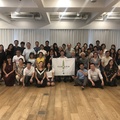When I was a kid growing up in the 1980s, one of the most desired objects was the Sony Walkman. Particularly a blue one that was made in Japan. By that time, Japanese products had a good reputation in Brazil; watches, cameras, TVs, or audio equipment manufactured in Japan were surely good products.
Except for the pencils. Like many kids, I liked to draw and write. When a relative traveled to Japan, I would often receive pencils as souvenirs. They were very beautiful, with detailed and amazing designs featuring characters I didn’t know. However, they broke easily. After just a few moments in the sharpener, those fine designs would transform into splinters. So, instead of using them, I decided to just keep them as collectibles.
According to my child’s reasoning, Japanese pencils must not have been very good because the country, being small, must have had few forests. Brazil, on the other hand, has many forests, allowing for the production of fine pencils. I never actually knew the reasons why the Japanese pencils I had were such poor quality. Maybe it was just an unfortunate coincidence.
As I grew older, I would often hear my parents saying, “This is good, it’s from Nihon (Japan).” One of the appliances my family appreciated the most was the suihanki (rice cooker). I remember that it really stood out from other devices because of its flower patterns. It also had buttons, which was fascinating to me, and I could not read what was written on it. I noticed that every family that owned a suihanki took great care of it, always keeping it covered with a beautiful cloth, and never lending it out.
One day, a relative came to São Paulo to buy a rice cooker. It had to be “made in Japan”—that was his only non-negotiable condition. I remember that the same brand had two models: one was made in Japan and the other, which was cheaper, was made in another country. That’s when I started to pay close attention to those small product labels, in order to determine the product’s country of origin.
Made in Japan
Basically, the phrase “made in” means that the product was either entirely made or significantly transformed in that country. Some countries set limits on the number of foreign components allowed for a product to qualify as made in that country.
Nowadays, the use of this label may be not very accurate, since large companies spread their production across different countries. Rules have been proposed to avoid consumer confusion and the use of the “Made in…” phrase as a mere marketing tool.
In the case of suihanki, I do believe the “Made in Japan” label has positive effects on marketing. Many of the products in my house were manufactured in Japan, or at least were made by Japanese companies. Television, video games, camera, cosmetics, umbrella…but not cars. My father was a big fan of German engineering, particularly German automobiles.
Advances in Japanese Manufacturing
Soon after World War II, Japanese industry started to rebuild. During that period, its products were low quality, with poor durability. With developments in technology and quality control, Japanese manufacturing improved greatly by the 1970s. “Made in Japan” then became synonymous with high quality, durability, and cutting-edge technology, and Japanese companies began to expand their operations around the world. Among the best known in Brazil are Kanban, 5S, and Kaizen.
In Brazil, Japan is known for electronics and cars. In the last decade, Japanese food has also gained in popularity. Soy sauce and rice are already well known; now, sake and green tea are piquing the public’s curiosity and the market's attention. Authentic ingredients imported from Japan still serve to differentiate one restaurant from another.
Every year, Japanese companies come to Brazil to promote their products at trade fairs in the food, retail, and hospitality sectors. Their main goal is to find local companies interested in importing and distributing the items in this country.
Made in Japan by Brazilians
For me, there is another layer of meaning with regard to products made in Japan. Thousands of Nikkei, including many friends and relatives, have migrated to Japan to work at factories. I believe these dekasegi have also contributed—and continue to contribute—to maintaining Japan’s good reputation.
When I see a product labeled “Made in Japan,” I think about these Brazilian Nikkei working on the assembly line, on product inspection, and so on. It takes a dedicated effort to perfect each unit that ends up on store shelves.
In my line of work, I use cameras and lenses made in Japan. I have a deep respect for these products and for the people who made them. My equipment is the best that I can afford; if there were better quality products available at fair prices, I would gladly consider buying them even if they were made elsewhere. I have yet to find any though, so for now, I am glad my equipment comes from Japan.
This brings up another childhood memory. A Nikkei friend had an uncle who moved to Japan during one of the first dekasegi waves. He would send gift boxes to my friend on a regular basis. They were filled with little things, usually school supplies, magazines, toys, and video game cartridges.
I was fascinated by it all. All these different things, so refined and full of beautiful details. Even though the gifts were obviously not meant for me, I would always ask my friend if another package from his uncle had arrived. I must have talked a lot about the gift boxes to my parents. They explained to me that my friend’s uncle was in Japan to work, and it was not easy for him to find time to buy gifts; it was also very expensive to send packages to Brazil.
Everything that came from Japan was like a treasure to me. I actually saw those distinctive packages from Japan as treasure chests. I kept very carefully all that I was given from Japan: telephone cards, postcards, key chains, stickers, and so on.
When I went to Japan myself, I kept and brought back to Brazil so many things: newspapers, flyers, discount coupons, point cards, train passes, grocery bags, packaging. They all brought back memories and I wanted to preserve them the best I could. Over time, I had to get rid of some items. Some I could sell; others, with much regret, I threw away.
You can now find many Japanese products in Brazil; they are not so rare anymore. Internet shopping has also made worldwide delivery possible.
For me, the “Made in Japan” label still has great meaning—it is something that inspires respect, trust, and nostalgia. However, I am still not over the mystery of the pencils. The next time I travel to Japan, I will buy some to sort it out.
© 2016 Henrique Minatogawa






